| Nine of Cups Island Hopping in the Caribbean - the Virgin Islands 2002-2003 |
| From the Spanish Virgin Islands we sailed on to St. Thomas in the American Virgin Islands. The SVI's, as part of PR, fly the PR flag while the AVIs have their own territorial flag to hoist. |
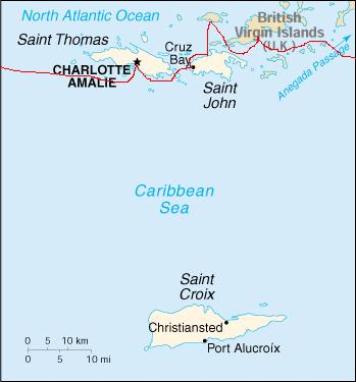
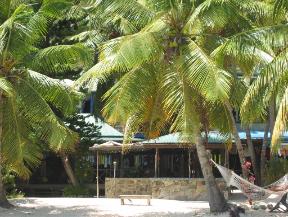
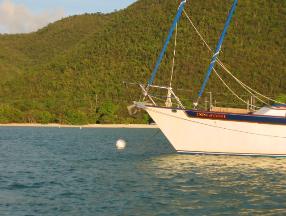
| In contrast to the hustle and bustle of St. Thomas, the island of St. John was quiet and laid back. Two thirds of the island is National Park land, with nearly 6000 acres donated to the U.S. government by Laurence Rockefeller in 1956. Pictured above is Cruz Bay. |
| The National Park in St. John maintains over 200 moorings which are free of charge. Anchoring many times damages delicate coral reefs and sea grass beds. Moorings help to protect the marine environment and were also quite a treat for us! |
| The British Virgin Islands consist of 4 main islands and a myriad of small islands. It is one of the most spectacular cruising areas in the world. Since we have spent a number of weeks cruising these islands in the past, we spent only a few days here this time, opting to spend more time in the Leewards and Windwards. |
| Virgin Islands info... The Virgin Islands were first “discovered” by Christopher Columbus in 1493 on his second voyage to the New World. Seeing the numerous islands, he named them Las Virgenes “the Virgins” in honor of St. Ursula and the 11,000 virgins who, threatened by the marauding Huns in 4th century Cologne, sacrificed their lives rather than submit to a fate worse than death. The Virgins have been owned or occupied by the Spain, France, England, Denmark, Holland, the U.S. and for a short while, the Knights of Malta! There are three Virgin Island groups today and each maintain a distinct heritage based upon their history : * Spanish Virgin Islands are part of Puerto Rico and include Culebra & Vieques. * American Virgin Islands are a separate U.S. territory and include St. Thomas, St. John and St. Croix. These islands were purchased from Denmark in 1917. * British Virgin Islands are still a British territory and include the larger islands of Tortola, Jost Van Dyke, Anagada and Virgin Gorda as well as numerous smaller islands. |
| One of the first buildings noticeable when you go ashore is Ft. Christian, built as a harbor fortification by the Danes in 1671. The clock was added in the late 1800’s. Ft. Christian is the oldest building still in use in St. Thomas and today is an historic site with a museum. |
| We took a cable car to the top of a hill overlooking the harbor. Pictured above is the harbor at Charlotte Amalie, St. Thomas as a rain squall approaches. |
| Culebra and Vieques are part of Puerto Rico and as such are distinctly Spanish. Vieques is known most notably as a site of contention because of the U.S. Navy’s continued use of the island as a naval aircraft bombing range. In order for cruisers to stop at Vieques, they must first make sure that the range is “cold”, i.e. no bombing exercises are planned. We opted to pass by Vieques, but stopped for a day and overnight at Culebra. It is known for its beaches and miles of shoreline. After the longer passages we've made, travelling in the Carribean is a treat. Although a couple of the passages are longer (75+ miles), most are pleasant dayhops from one island to another. The distance from St. John, AVI's to Jost Van Dyke, BVI's for instance, is only five miles. In that short distance, we travel not only to another island, but to another country, another round of customs/immigration, new culture, different foods, different currency, sometimes a different language... but all part of the adventure |

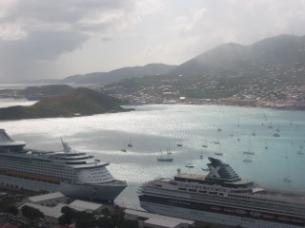
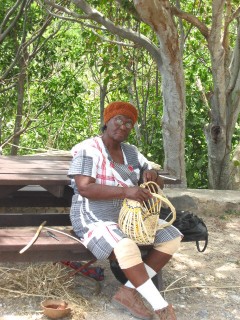
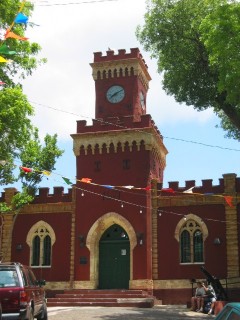
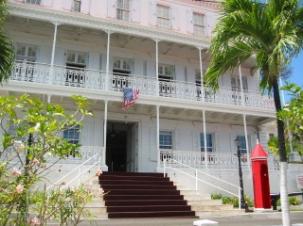
| We spent a day or so exploring the town of Charlotte Amalie. Government House was built in 1867 for meetings of the Danish Colonial Council. The little red guardhouse still stands. The building is now used as the offices of the Governor of the Virgin Islands. |
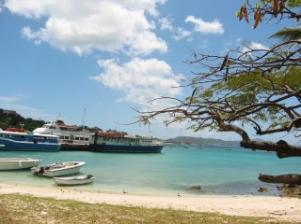
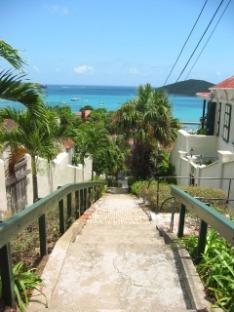
| The 99 Steps…(but actually there are 103, I counted) built in the mid-1700s, they lead from the lower city to Government House. Danish architects, who had never been to St. Thomas, insisted that the city be laid out in orderly grids, despite the hilly terrain. Hence, there are a number of sets of stairs throughout the city built to facilitate the climb. The steps are made of Danish brick brought from Denmark in the holds of ships where they were used as ballast. |
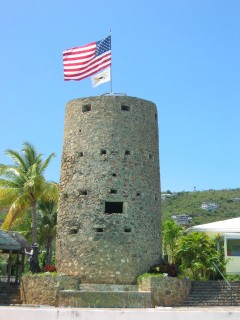
| Climbing up even more stairs, we came to Blackbeard’s Castle built in 1669. Legend has it that it was built by Blackbeard the Pirate (Edward Teach), but more historic authentication indicates it was a military fortress built to augment Ft. Christian and was originally called Ft. Skytesborg |
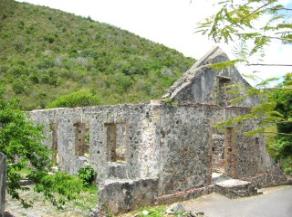
| While exploring, we happened upon a basket weaver. Among other bits of sage advice, she told us that reeds for baskets were only collected “at the dark side of the moon at low tide", otherwise they would be bug-infested. Interestingly enough, we heard this same story from basket weavers throughout the Carib and South America. |
| St. John’s early commerce was comprised primarily of sugar production and bay rum oil for the making the making of cologne.The best sugar factory remains are those at Annaberg, (pictured above) once owned by William Gottschalk, a planter-owner from St. Thomas. |

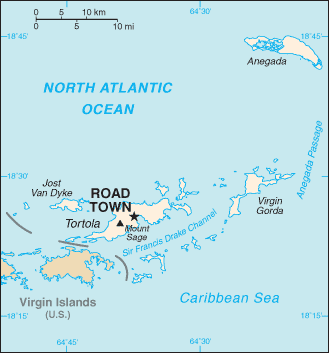
| One of the islands, Jost Van Dyke, is the location of a famous cruisers' bar named Foxy's, pictured above. In the "small world department, the bartender at Foxy's went to high school with my sister, Lin, in Leicester, MA. Who would have thunk it? |
| Next, we head to Anguilla. If you care to come for the ride, just click! |
| Spanish Virgin Islands |
| The Virgin Islands |
| American Virgin Islands |
| British Virgin Islands |
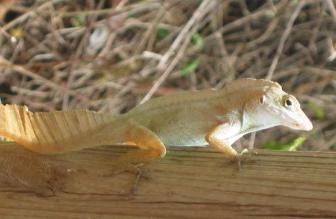
| A number of endemic anoles like this one inhabit St. Johns. |
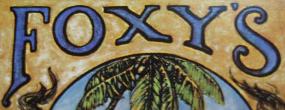
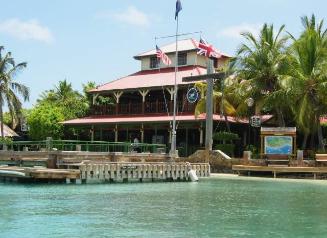
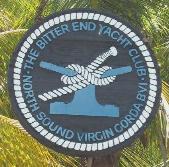
| We'd visited the Bitter End Yacht Club on Virgin Gorda before and decided to visit again. It's a classy, expensive place, but worth the stop just for its charm. |
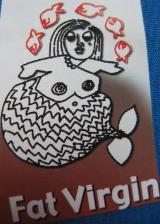
| On the Menu… Roti – a filling of curried chicken, beef or fish wrapped into a crepe-like shell. Kind of like a Caribbean burrito. Callaloo – a soup of callaloo greens (or spinach), okra, garlic and spices |
| Virgin Gorda was named the “Fat Virgin” by Columbus because of the island’s seaward resemblance to a fat woman lying on her back. The island is 10 miles long and boasts a populaton of about 8,000 people. The Spanish mined as much as 10,000 tons of copper here from the mid- 16th to the mid-19th century. |
| The Bitter End…the loose end of any line that comes out of a knot. Most “bitter” when it’s the inboard end of an anchor rode and not securely attached to the boat. |
| By law, the Britsh Royal Navy was required to provide each member of the crew ½ pint of rum per day. Yo, ho, ho and a bottle of rum. In this place, the rum would be Pussers. |